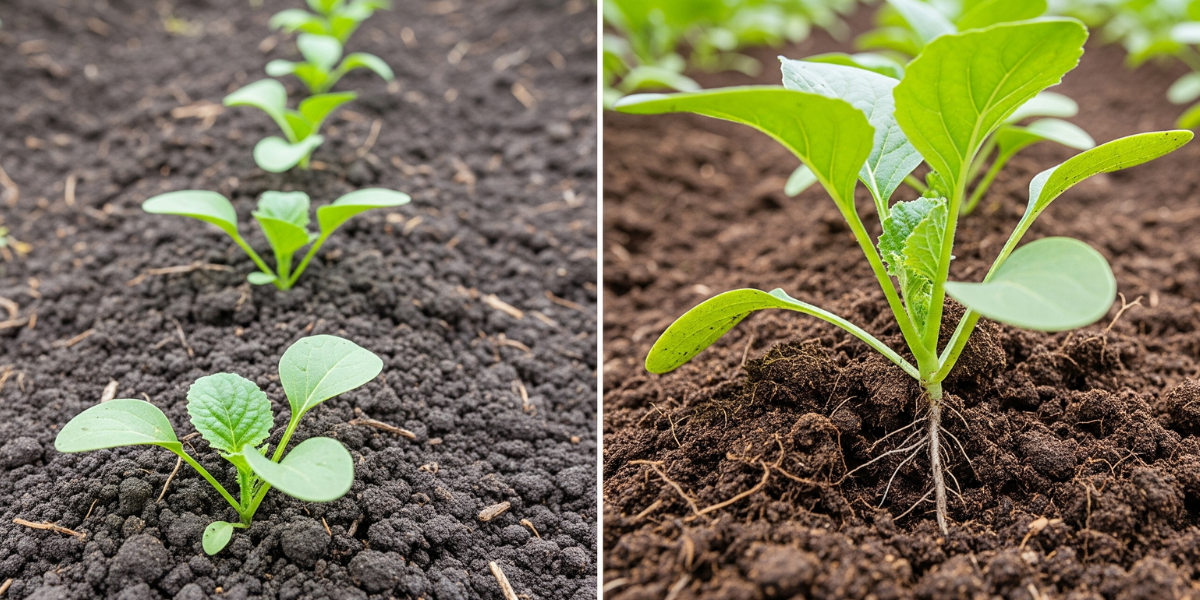Picture this: You're at the dinner table, watching your kids push around store-bought vegetables that taste like cardboard. Meanwhile, your neighbour's homegrown tomatoes are so flavourful they practically glow. The frustration hits – you've tried growing your own, but despite your best efforts, your garden keeps disappointing.
Here's the truth most Aussie gardeners discover too late: You can't grow nutrient-dense vegetables in nutrient-poor soil. No matter how much you water, weed, or wish upon a star.
You've added compost, mulched like a champion and watered religiously – yet the growth just isn't cricket. Sound familiar? You're solution aware: you know organic is the path, but the missing link is targeted soil boosters that switch your dirt from "she'll-be-right" to "flamin' unreal".
The Hidden Cost of Weak Soil (It's Not Just Your Wallet)
When your soil lacks the right minerals and microbes, your vegetables lack the nutrients your family needs. That capsicum might look red and shiny, but if it's grown in depleted soil, it's delivering a fraction of the vitamins and minerals it should.
Living soil is a bustling metropolis of microbes, minerals and organic matter. Feed that ecosystem the right ingredients and it pays you back with stronger roots, juicier fruits and pest resistance that'd make a chemical spray blush.
Want the full blueprint for building this powerhouse soil from scratch? Check out: Living Soil: How to Build Australia's Best Garden Soil (Complete Guide 2025)
The good news? Australian soils respond incredibly well to targeted organic boosters – especially our challenging clay-heavy soils in Melbourne and Sydney, or the sandy coastal strips where nutrients leach away with every decent downpour.
Meet the 7-Piece Aussie Organic Gardener's Toolkit
Below you'll meet seven, field-tested organic additives that every fair-dinkum gardener keeps handy. Each one tackles a specific weakness in typical Australian soils, from our notorious pH swings to the mineral lockup that happens during our intense summers.
Quick note: All the products mentioned are available through our mates at Dr Greenthumbs – they're lab-tested, sustainably sourced and packaged right here in Aus.
|
# |
Booster |
What It Does |
When to Use |
Quick How-To |
|
1 |
Natural source of nitrogen + growth-hormone triacontanol |
Early veg stage or when foliage looks pale |
Work ½ cup per m² into top 5 cm of soil |
|
|
2 |
Fish & Kelp Meal |
Delivers N-P-K + trace minerals and plant-stimulating hormones |
Seedling transplants & stress recovery |
Sprinkle ¼ cup per m² and water in |
|
3 |
Slow-release P & Ca for root building and flowering |
At planting and again before bloom |
½ cup per m² mixed through root zone |
|
|
4 |
Gypsum & Limestone Blend |
Balances pH, adds calcium + sulphur, improves structure |
When soil is tight, acidic or sodic |
1 cup per m² broadcast then lightly fork |
|
5 |
Creates long-term carbon habitat for microbes, locks in nutrients |
Any time you refresh beds or potting mix |
2-5% of total soil volume, pre-soaked in compost tea |
|
|
6 |
Concentrated organic slow release nutrition |
Bed prep and mid-season top-dress |
1 cup per m² |
|
|
7 |
Extra P, K and bloom-boosting nutrients for fruiting |
First sign of buds through harvest |
¼ cup per plant every 3–4 weeks |
(Full directions on each product label – no dramas.)
Why These Seven Make the Dream Team
1. They Complement, Not Compete Unlike one-size-fits-all fertilisers, each booster targets a specific gap: nitrogen kick, root ignition, microbial horsepower or pH balance. Layered intelligently, they create a self-balancing loop that keeps nutrients cycling and problems at bay.
2. The Living Component Super-Charges Everything Dry amendments lay the mineral foundation, Go & Grow inoculates and feeds beneficial bacteria & fungi, while Bud & Bloom spikes the soil microbiome right when fruiting plants demand it. Think of microbes as the courier crew delivering minerals straight into root cells, and their food source calls in different shifts.
3. Field-Tested in Aussie Conditions From the red loams of WA to the sandy coasts of NSW, Dr Greenthumbs products work in every part of the country across harsh summers and fickle downpours. Over 2500+ five star reviews leaves you confident you're not buying snake oil.
It’s no wonder more and more households are making the switch—here’s why: Why Smart Aussie Families Are Ditching Chemical Fertilisers (And How to Join Them Without Sacrificing Results)
The Planting Window Is Closing Fast
Spring planting season is knocking, and here's what most gardeners get wrong: they scramble to prepare their soil after the optimal planting window has already opened. The best time to build your soil was three months ago. The second best time is right now.
With unpredictable weather patterns becoming the norm across Australia, having resilient soil isn't just nice to have – it's essential. Soil rich in organic matter and beneficial microbes bounces back from drought stress, handles heavy rains without waterlogging, and maintains steady nutrient release even when temperatures soar.
Step-by-Step Game Plan to Deploy the Toolkit
Step 1 – Diagnose Your Dirt Grab a handful: does it clump like wet cement or sift through fingers like beach sand? Either way, structure comes first. Mix in biochar and the gypsum blend to open pore spaces and stabilise pH.
Step 2 – Set the Nutrient Bedrock Pre-mix rock phosphate and alfalfa meal before sowing. These slow-release sources feed steadily for months, meaning fewer top-ups and no nutrient burn.
Step 3 – Inoculate with Life Dampen the soil, then broadcast Go & Grow™. The product's humic acids instantly buffer salts, giving microbes a comfy new lounge room to colonise.
Step 4 – Maintain the Momentum Every three weeks, work a dusting of fish & kelp meal into the top layer and water with a mild compost-tea – it re-awakens dormant microbes.
Step 5 – Flip the Bloom Switch When flower buds or fruit set appear, side-dress with Bud & Bloom™. Its higher potassium plus phosphorus push energy toward blooms, while Bacillus bacteria guard against blossom-end rot.
Common Pitfalls (and How to Dodge Them)
Over-doing the dose: More is not better. Stick to label rates – living soil amplifies effects.
Neglecting moisture: Dry beds = sleeping microbes. Keep soil evenly damp (but not soggy).
Skipping pH checks: Even organic soils drift. Test quarterly; aim for 6.2–6.8 for most crops.
Why the Investment Pays for Itself
Yeah, quality organic soil amendments aren't the cheapest option upfront. But here's the maths that matters: One packet of each booster treats 10-20 square metres and lasts an entire growing season.
Compare that to buying organic vegetables at $8-12 per kilo, and you're looking at payback within the first month of harvest. Plus, improved soil structure means better water retention (lower water bills), fewer pest problems (no rescue sprays needed), and harvests that keep producing for months.
The shipping might sting a bit, but when you're getting restaurant-quality vegetables from your backyard while knowing exactly what went into growing them, it's hard to argue with the value.
Ready to Build Your Own Toolkit?
Your family deserves vegetables that actually taste like vegetables – packed with flavour and the nutrients that supermarket produce simply can't deliver. The difference between thriving soil and struggling soil often comes down to these seven targeted boosters.
Swing by our Organic Garden Fertiliser collection – every booster above is waiting for you, plus bundle deals that save a motza. Grab what your garden's craving and watch your plants go off like a frog in a sock.
Don't wait for next season to start building better soil. The longer you delay, the longer your family misses out on the nutrition and flavour that only comes from truly healthy homegrown vegetables.
Give Your Soil Some Love, Reap the Rewards
Healthy soil isn't an expense; it's the engine room of every future harvest.
If you’re starting with lifeless, compacted dirt, these tips will kickstart a living, self-feeding garden in record time: 5 Field-Tested Secrets That Turn Dead Dirt Into a Self-Feeding Garden (While You Sleep)
Stock these seven boosters, apply them smartly and you'll enjoy hardier plants, richer flavours and brag-worthy yields – all without a whiff of synthetic chemicals. Your dirt will never look back, and neither will you.
Ready to transform your garden from disappointing to dining room-worthy? Check the collection link above and get started today. Your future self (and your family's taste buds) will thank you.
Keen to put theory into practice? Check this out, or fire any curly questions our way in the comments. Happy growing, mate! 🌱🌞
About the Author





